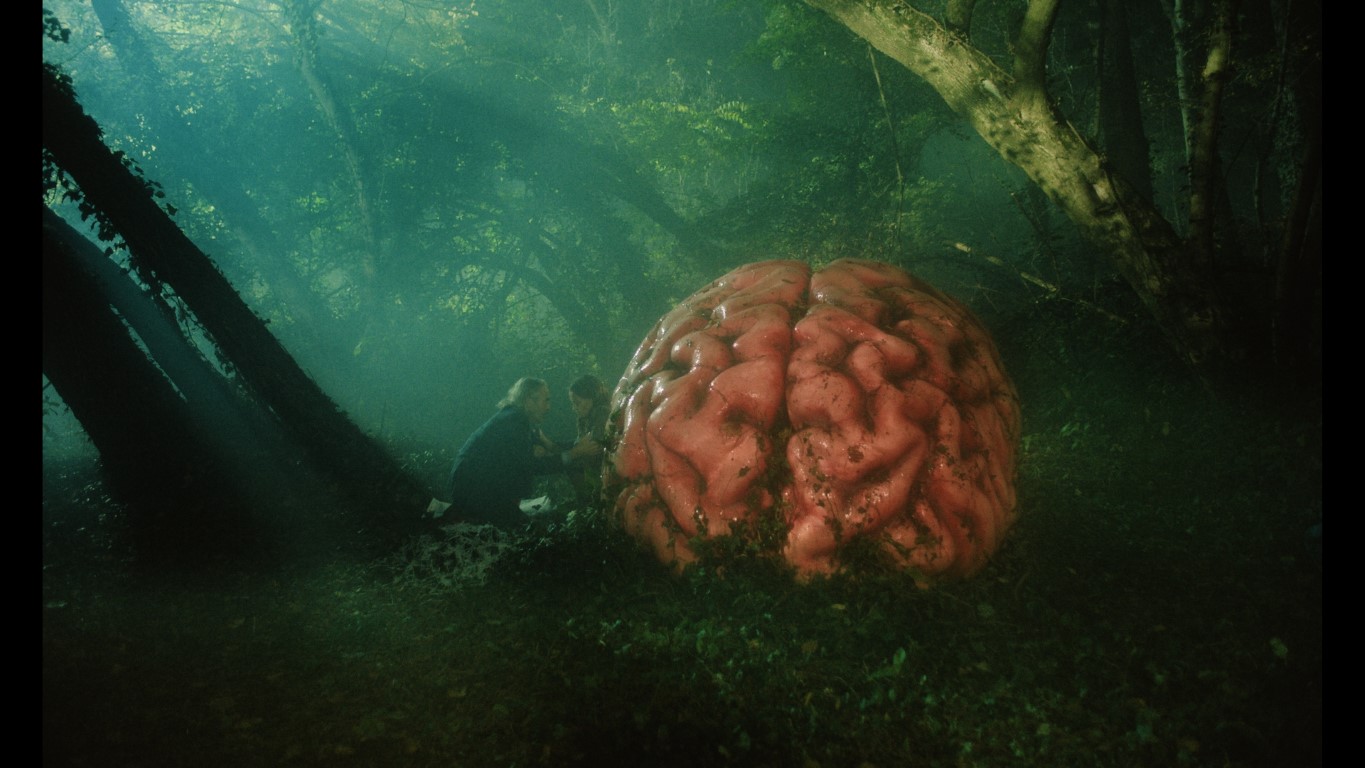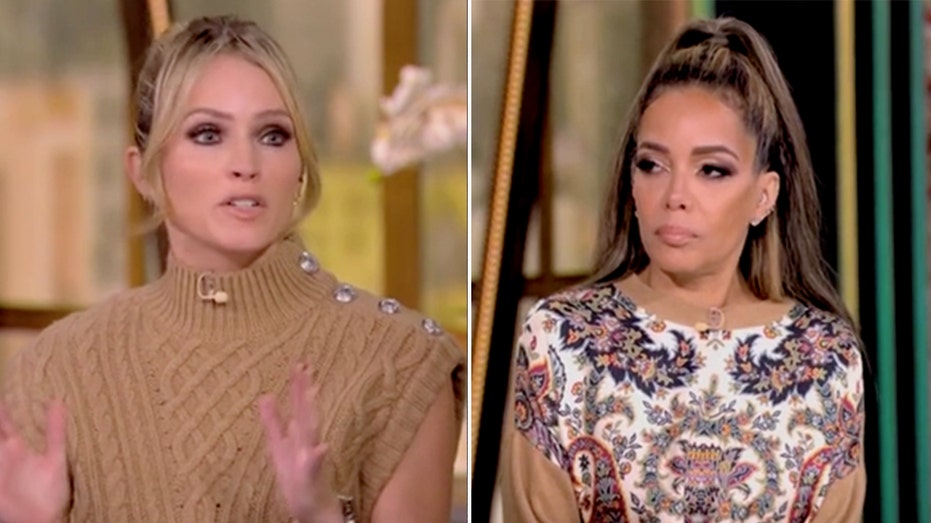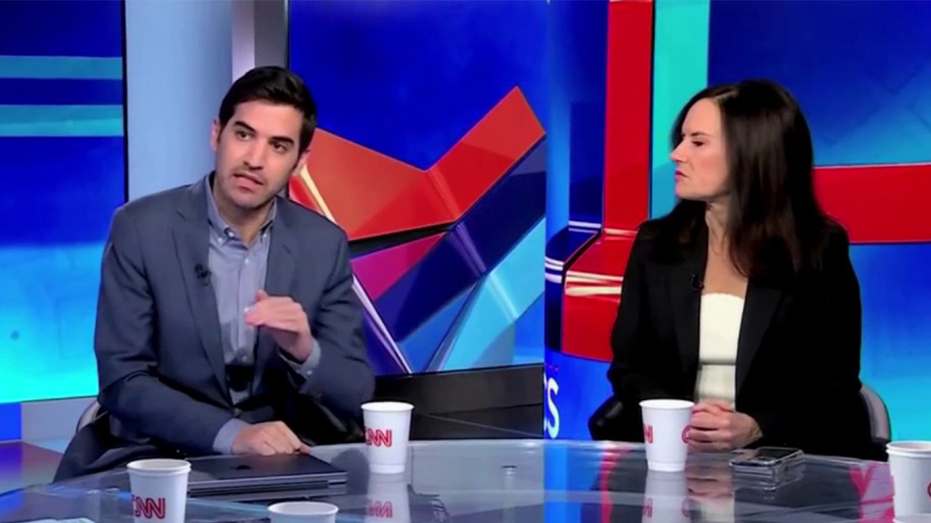Over the last forty years, the singular artist Guy Maddin has been celebrated as one of Canada’s most well-known and idiosyncratic filmmakers. Hailing from Winnipeg, Maddin’s films are a genre unto themselves. Along with his thirteen feature films, Maddin has also directed over fifty short films, published several books, created many art installations, and is an avid collage-maker. Co-written and co-directed with brothers Evan and Galen Johnson, his latest feature, “Rumours,” starring Cate Blanchett as a beleaguered world leader, premiered in competition at this year’s Cannes Film Festival.
Maddin’s path to filmmaking was a rocky one. After studying economics at the University of Winnipeg and suffering a few personal losses, he worked a series of odd jobs, including bank manager, house painter, and photo archivist. Eventually, he began taking film classes at the University of Manitoba. There he befriended professor and experimental filmmaker Stephen Snyder, at whose film screenings Maddin met filmmaker John Paizs, director of the surrealist comedy “Crime Wave.” Of his early work, Maddin has said he was inspired by the films of Snyder and Paizs, as well as Luis Buñuel’s “L’Age d’Or” and David Lynch’s “Eraserhead,” enchanted by the honesty of their “atmospheres and ideas.”
Like those filmmakers, Maddin’s early films are noted for their fanciful and often surreal tones and their silent film era aesthetics, which he achieved by filming on 16mm or Super-8mm, often in black and white. In the 2000s, Isabella Rossellini appeared in several of Maddin’s films, including an adaptation of Kazuo Ishiguro’s “The Saddest Music in the World” and “Keyhole,” which blends elements of gangster and haunted house films with Homer’s “Odyssey.” In his review of Maddin’s fifth film, “Dracula: Pages from a Virgin’s Diary,” Roger Ebert wrote, “So many films are more or less alike that it’s jolting to see a film that deals with a familiar story, but looks like no other.”
In 2015, Maddin collaborated with fellow Winnipegger Evan Johnson on “The Forbidden Room,” an experimental fantasy drama with an ensemble cast that included Charlotte Rampling, Udo Kier, Adele Haenel, Mathieu Amalric, Maria de Medeiros, Geraldine Chaplin, and the band Sparks. Also that year, Evan’s brother Galen Johnson joined the duo, turning them into a directing trio with the short documentary “Bring Me the Head of Tim Horton.” In 2017, the filmmaking triumvirate released “The Green Fog.” Commissioned by the San Francisco Film Society in honor of the 60th San Francisco International Film Festival, the film is a loose interpretation of Alfred Hitchcock’s “Vertigo,” told via a collage of footage of San Francisco taken from old movies and television shows.
With their latest film, “Rumours,” the trio uses their unique cinematic syntax to lampoon world politics. Once again featuring an impressive ensemble cast led by Cate Blanchett, Alicia Vikander, Nikki Amuka-Bird, and Charles Dance, the satire follows world leaders at the G7 summit as they attempt to draft a joint statement about an undefined global crisis, only to find themselves lost in the woods overnight, where romance arises and re-animated bog bodies threaten their very lives.
During the Toronto International Film Festival, RogerEbert.com sat down with the directors at the Fairmont Royal York to discuss the origins of their new film, Maddin’s path to silent filmmaking, the anti-poetry of AI, and Cate Blanchett’s exquisite comic.
This interview has been edited for clarity and length.
The film is set during the G7 summit and you have these heightened versions of dumb politicians. At what point in the process did you decide what aspects of say Germany and its leaders that you wanted to lampoon?
Galen Johnson: We weren’t looking to make programmatic stereotypes because we knew that people would do the work and project the current leader onto them no matter what. So we tried to throw in things like the British accent on the American president. So, we were mostly swerving away from those stereotypes. But our French president is a blowhard intellectual, and that’s sort of the way all French presidents have been. So that is sort of based on a stereotype, I guess, but it also reflects reality.
Evan Johnson: I remember when we started, we had character names. We thought, “this name sounds German, this name sounds French.”
Guy Maddin: The Italian character was just named after a Winnipegger, an Italian Winnipegger we know. That was the character. He’s not like Silvio Berlusconi.
GJ: No, he’s the anti-Berlusconi.
EJ: He’s just a barista we know.
GJ: Nice guy.
GM: Then the characters started interacting.
EJ: I don’t think we’re thinking a lot about national characteristics at first. We’re just thinking about what makes a good character. What would be fun? What’s good chemistry between two characters? What if these two became friends and these two ran off and had sex? Then the accents are there, and they have flags in front of them, which does a lot of the rest of the work. Then people, even though we deny that they were thinking about these characteristics, everybody, for all the reasons we’ve said, will say, “That’s based on Justin Trudeau, or that’s based on Angela Merkel.” But that was not the case when we were writing.
GM: You get them interacting with each other on this one night as if it’s the last night of high school, grad night, an endless enchanted night where many adventures and romances saturate the air. That spirit, as much as anything, informed what happened.
Did the casting change how you crafted some of the characters?
GJ: The Italian prime minister may have felt more like an Italian stereotype on the page.
EJ: That’s what the page is like.
GJ: All his lines had exclamation points at the end. Then Rolando Ravello basically read the lines without exclamation points, and it became, oh, this is not as stereotyping.
GM: He read them more naturalistically than we heard them in our heads. Then Denis Ménochet, our French president, is the way he acts and performs. He deeply researches and becomes his character, no matter how ridiculous it is. He researched sundials and wrote an essay on sundials just to get into character. It’s well written. So the next thing you knew, his little monologues and speeches became – we were hoping they’d be great – but they were more detailed and soaked with him. But we never changed the writing for them.
I wanted to ask about the brain. Obviously, it’s the key piece of imagery we’ll see, but the minute I saw it before I saw the film, it made me think of the sort of color palette of “Dr. X,” the pre-code horror movie. As a cinephile, I was curious if that was in your brain at all.
GM: I’ve never seen that movie, but it’s on my list of things to see. It looks beautiful. It’s a two-color Technicolor.
GJ: It’s got that pink and that green.
It’s very similar.
EJ: We spent a lot of time on the palette for our previous feature,
“The Forbidden Room.”
GM: Which was in Technicolor.
EJ: Yeah, it was in that pallet. But for this one, no it never occurred to me.
GM: It makes your eyes feel good, that palette.
EJ: But I know when we were color grading “Rumours,” we kept leaning on the green and and on the pink, which must be because of that palette.
I wanted to ask about the bog bodies, because obviously those are real things, but you take them to a very extreme place.
GM: Yes, we re-animate them.
How did you first come across the bog bodies, and how did you realize that was going to be kind of a through line metaphor?
GJ: I think we first became excited, or I became excited with them, seeing a documentary on them, and there were some archeologists, or whatever they are, who study bug bodies, lifting a bog body up onto a gurney or something, and I just loved the texture of it. It was so gelatinous and disgusting. I just fell in love with that and the idea of something boneless.
GM: I’ve never so when you mentioned that–
GJ: They look amazing. Look so fucking cool, yeah. It was always one of those things that we wanted to have in a movie, and this is the one we put it in.
GM: I have a pathological connection with the past, always trying to exhume it and experience it. And the idea that someone’s fingerprints and eyelashes are preserved from the Iron Age is amazing. So that was my way in, or that was what got into my heart, and then it found its place in the script as kind of a, I guess, a mirror of the leaders. Some theories hold that these bog bodies were tribal leaders who were ritualistically sacrificed in favor of better crops.
Your films are very tactile. You feel moments and then you feel the snow, you feel bodies, you feel everything. Do you start with that tactile imagery in your head?
GM: Going over the many decades I’ve been doing this, I see that it’s a little different for each. Sometimes, it’s the spirit of the movie I start with. Sometimes, it just seems to be more wed to the words. And other times, it’s a flavor or a look. This time, we knew what we wanted it to look and feel like, I think, all along, maybe specifically shot by shot. With this one, Evan wrote the script based on a story we wrote together. The line-by-line composition of the dialog got me airborne, and I was very pleased with that.
What was it like working with Cate Blanchett? She seems really cool.
GJ: She’s extremely cool. Very smart, very good in every aspect. Not just the acting, every aspect of this whole project.
GM: She’s good at keeping everyone focused.
EJ: She’s really easy. There’s stuff that comes along with her. It’s not because she brings it. It’s just because, when you get stars, other things come along like, people come, like parasites [laughs]. I don’t mean her team.
GJ: No, no, no.
EJ: It’s just that other stuff starts to tumble, and the production gets bigger than you originally intended and probably bigger than she wanted. That kind of thing does happen.
GJ: But she’s good at recognizing that and then protecting you. She’s an incredible person to work with.
EJ: She’s fun.
GJ: And funny and quick-witted.
GM: You cannot fool her.
EJ: We tried.
[everyone laughs]
GM: But if you say, “That was a great take,” she’ll go, “Horseshit” as she watches it on the monitor, and then goes, “Again!” You know? So it almost doesn’t matter what you say about the take.
Do you do a lot of rehearsing for a film like this, which has so many scenes with many characters talking to each other at once?
EJ: We tried to rehearse for a few days. A lot of what we were doing was just running the scene. You can rehearse a bit, but if you’re not in the location where you’re shooting the scene, it doesn’t come to life.
GM: Some rehearsals can just depress you.
EJ: But once you get them on set, bring them out, and start recording, it’s great. We were doing a lot of conventional coverage of the scenes so that they would do the scene, and we shoot it wide a few times, and once you’ve shot the scene a few times, everyone’s loosened up, and the ideas are getting better. Then you go in tighter, and the scene gets better. So you’re rehearsing on the day.
GJ: You can’t really storyboard seven-part conversations. You want to give your actors the freedom to move around.
I wanted to ask about the AI bot. A lot is going on with AI, obviously, right now, specifically in terms of training and machine learning. At what point did you decide that was going to be part of the ending, which almost seems like a deus ex machina, and then suddenly it’s very much not.
GJ: We wrote this just before AI became ascendant in the popular imagination, so the idea felt more novel. Whereas now I look at it, and it’s like, “Oh, they’re jumping on the AI bandwagon.”
EJ: Two and a half years ago is when we wrote it.
GJ: Yeah, it was just before ChatGPT and all that stuff, but you could still feel it getting closer.
EJ: There was a day when ChatGPT got a bug in it and started just spouting nonsense, like poetic nonsense. Like, unbelievably beautiful stuff, yeah? Like, Joycean language. It was beautiful, really funny. It was, like, the only time ChatGPT–
GM: Did something good.
EJ: If you’ve ever used ChatGPT and asked it for something poetic, it can’t do it. Until the error, which was making it into an artist. Suddenly, something was wrong with its brain, and it became this beautiful writer. Then the engineers were like, “Oh, fix it. Fix it!” So they fixed it, and now you can’t get anything beautiful anymore. That does tell you something about how art is viewed.
GM: It’s like how parents fix children and teach them the correct way to draw or something like that.
You’re all artists, so you’re always noodling with things. At what point do you realize you have something that will turn into a film? Is there a moment?
EJ: There’s a moment, with us especially, when we can summarize a movie in one sentence.
GM: It feels good.
EJ: We have scripts that we love and scripts that we think would make a good movie, but we haven’t been able to summarize them into a sentence yet. So we’re reluctant to–
GJ: You want it to be like one object, not a bunch of different things that don’t add up to more than the sum of their parts.
EJ: Because films are a notorious assemblage of a million different things, cobbled together in a million different places, they’re supposed to feel like one thing.
What was your one sentence for this film?
GJ: “G7 were trying to write a statement, fail, and then get lost in the woods.”
EJ: It was simple. But obviously, for something like “The Forbidden Room,” and we couldn’t–
GM: That was not simple.
EJ: It would take us forty-five minutes to summarize it.
GM: The elevator pitch would take the world’s tallest building.
EJ: Yes, exactly. And same with some of your other movies. You know, some of them have quick pitches, like “Careful.”
I love “Careful.”
EJ: “Careful” is the best. It’s being restored.
Is it? I can’t wait. That’s what I tell people to see all the time.
GJ: Not over-restored, I hope.
GM: No kidding.
I love silent films. I watch them a lot. Do you still make time to watch new ones that you haven’t seen before?
GM: Yeah, now and then. Not on a regular basis, but I didn’t even start making silent films as a silent film fan. I just sort of evolved in a Darwinian process. I started making films, realizing I could shoot black and white better than I could color and that I didn’t know how to light with more than one light. So I started getting deep, dark German expressionist shadows. I just evolved quickly into a silent filmmaker.
Then I started watching them, reinforcing my strengths, and making more of them. I was called a silent filmmaker for years before I made a silent film, really, because I made a film with talking. My first, second, and third, “Tales from the Gimli Hospital,” and my fourth film, “Twilight of the Ice Nymphs,” had too much dialog to be subtitled. It’s the only one my French distributor never picked up. Then, I made my first silent film, “The Heart of the World.” Then, in the ballet picture, the ballet “Dracula” is silent. And then “Cowards Bend the Knee” and “Brand Upon the Brain!,” they are silent movies. I had a good time with them but was just making films. People even said that “Twilight of the Ice Nymphs” was a silent movie.
I wanted to ask about your collaboration. Obviously, there are three of you as directors. Do you break down certain aspects of directing? What is it like on set when there’s three of you?
[Answering simultaneously]
GM: We stick pretty close together.
GJ: We make decisions together.
EJ: We listen to each other.
GJ: During pre-production and post-production, there becomes a lot more division of labor, but when you’re on set, you don’t want to be telling different things to the actors, being three directors, directing in different ways, and just canceling each other out. So we tend to stick close together and if we need to discuss something, we have a quick little huddle. But we’ve spent so much time together in post or pre-production that we’re all on the same wavelength.
GM: A three-headed director.
GJ: We’re auditioning for a fourth.
So, obviously, this film is coming out during, at least in America, a pretty big election. I know you started on a film a few years back, but was that something you were thinking about since there’s so much politics in the film?
GJ: I think politics is always going on, so there are always weird parallels. We had no idea when this thing would be released because you never know how long a movie is going to take to make.
GM: It does have the illusion of feeling of the moment, though, somehow.
It spoke to a lot of my rage.
GM: It’ll always be of the moment, I hope.
Earlier, you said that when people watch the film, they project whoever’s the leader at the moment. Are you finding that with audiences that, say, an American projects a bit of what’s happening in America?
EJ: I don’t think we’ve screened it enough yet maybe to know. The film was at Cannes and we were there.
And it screened at Karlovy Vary.
EJ: But we weren’t there. We didn’t do any of the European festival circuit tours, so we haven’t talked to audiences much. When we make a movie, we want to move on to the next one.
GJ: Put it in a vault and move on to the next one.
EJ: But I’ll be interested to see how it plays with different audiences. Like tonight, the film is playing in Toronto, Canada, in our home country. It’ll be interesting to see–
What jokes get bigger laughs?
EJ: Yeah, exactly.
Is that something when you’re cutting? Do you show the film to test audiences and see when they laugh? Or is that you just kind of trust it?
GJ: I mean, we didn’t have that. We showed it to a few people.
EJ: No, I don’t think we ever saw it with an audience, except at its world premiere. Until then, we didn’t know quite what it would be like.
GM: Or how the audience would react. We had no idea.
EJ: We were not entirely surprised by the laughter, but we thought it would be more like a quiet laughter. You know, the kind you call inner laughter. People are just going, “hmmm,” and stroking their chins. But there was more laughter than expected.
GJ: And it was never at the parts we thought were funny.
EJ: That’s reassuring.
GM: Yeah, we were just totally wrong about what’s funny.
Was there laughter on set?
EJ: Yeah, when we write, and when we make it, we make each other laugh. And if something makes us laugh, it often ends up in the movie.
GM: The actors are good at details, too, and putting a laugh in where you wouldn’t expect it.
Cate, I feel like, is an underrated comedic actor. Her timing is exquisite.
GM: She’s a great comedian. I don’t know if you’ve seen her “Documentary Now!” episode, “Two Hairdressers in Bagglyport.”
Yeah, she’s so funny in that. I don’t know why she doesn’t do more comedies.
EJ: Because she’s so good at everything.
GJ: I don’t think there’s a lot of good comedy scripts going around.
EJ: They’re hard to write. There’s something about laughter that just, I don’t know. . . I don’t understand why it feels like it cheapens things or–
GJ: It undermines drama sometimes.
GM: And comedies never win Academy Awards.
EJ: And they’re hard to make.
How do you hope people will feel when they’re done with the film, once they’re leaving and back into the world?
GM: The ending is embarrassing for me because I want them to be so gobsmacked, puzzled, excited, desirous of seeing it multiple times, and desirous of telling all their friends. I want that, but that’s what every filmmaker feels.
EJ: I can’t honestly say that this is in our hearts, but it would be nice if people were annoyed—not annoyed at the movie, although I like annoying people,, too.
GM: Yeah, a little bit annoyed.
EJ: But annoyed at the world and the state of things. That would be nice. But part of the struggle of dramatizing the movie is our struggle of, like, trying to write something that will mean something to people, but not being up to the task, like, that’s what the movie’s about, and that’s what we felt writing. How do we make something serious that matters when we’re just seven morons, you know? So I’m not sure people will leave feeling a strong message, but it’d be nice.
My reaction was that, because I’m so angry about everything all the time, sometimes you just have to laugh.
GJ: When you’re angry, you’re already losing.
EJ: Or you’re in danger of burnout if you’re angry too long, and then you need to get angry again, but it’s a good relief to let it out.


:format(jpeg):quality(80)/wp-content/uploads/2024/10/proiect-modificare-legea-sportului-steaua-dinamo.jpg)

:format(jpeg):quality(80)/wp-content/uploads/2024/10/cometa-vazuta-acum-80000-de-ani-vazuta-la-mangalia.jpg)


:format(jpeg):quality(80)/wp-content/uploads/2024/10/universitatea-craiova-fcsb-play-off-superliga-superbet-6052024-13-scaled.jpg)


:format(jpeg):quality(80)/wp-content/uploads/2024/10/irina-razvan-fodor.jpg)

:format(jpeg):quality(80)/wp-content/uploads/2024/10/un-barbat-si-a-distrus-masina-ca-sa-insceneze-un-furt.jpg)

:format(jpeg):quality(80)/wp-content/uploads/2024/10/salata-carmen-bruma.jpg)

:format(jpeg):quality(80)/wp-content/uploads/2024/10/raul-florucz-si-mircea-lucescu.jpg)
:format(jpeg):quality(80)/wp-content/uploads/2024/10/zodii-astre.jpeg)
:format(jpeg):quality(80)/wp-content/uploads/2024/10/impacare-istorica-giovanni-becali-anamaria-prodan.jpg)
:format(jpeg):quality(80)/wp-content/uploads/2024/10/bank-atm-operation-enter-password-scaled.jpg)

:format(jpeg):quality(80)/wp-content/uploads/2024/10/madalina-ghenea-instanta.jpg)
:format(jpeg):quality(80)/wp-content/uploads/2024/10/neil-lennon-l-a-analizat-pe-ianis-hagi-si-a-dat-verdictul-sau.jpg)



:format(jpeg):quality(80)/wp-content/uploads/2024/10/romanesco-conopida.jpg)


:format(jpeg):quality(80)/wp-content/uploads/2024/10/chefii-au-dat-afara-o-grupa-intreaga-de-concurenti-la-masterchef-2024.jpg)
